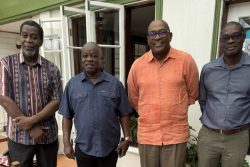The Civil Defence Commission yesterday hosted an oil spill tabletop exercise the aim of which was to test and develop Guyana’s oil response capability.
A number of stakeholders were involved in the exercise which was held at the CDC’s headquarters on Thomas Road, Thomas Lands, George-town. The activity was described as a “command post” exercise where all the players within the different agencies identified and played their role. It is a part of a regional security exercise known as “Exercise Tradewinds” which contains a component for disaster response.
Tabletop exercises are discussion-based sessions where team members meet in an informal, classroom setting to discuss their roles during an emergency and their responses to a particular emergency situation. A facilitator guides participants through a discussion of one or more scenarios.
According to the Director General of the CDC, Lieutenant Colonel Kester Craig, as part of the Exercise Trade- winds which is set to be held in June, they will be testing two components of the national disaster mechanism; those are, the oil spill and flood response components. “Leading up to that we’re doing a series of training and exercises to ensure the players know their responsibilities, understand what they want to do and the best way to do that is through exercises” Craig said. He added that the exercise will further orient the stakeholders to the roles and responsibilities of their various organisations.
Present at the exercise yesterday were representatives of the CDC, Guyana Defence Force (GDF), Guyana Geo-logy and Mines Commission (GGMC), United States Embassy, National Aeronautics and Space Administration (NASA), United States Coast-guard, Ministry of Public Health, Guyana Police Force, Guyana Fire Service, Mari-time Administration Department (MARAD) and Environmental Protection Agency (EPA) among other local and international organisations.
It was noted that during the exercise which was conducted throughout the day, the CDC sent out what were known as “injects” to the representatives and the players would then have to take certain actions based on their organisations’ roles and responsibilities. “Based on the responses, we will be looking at the responses and the action taken and gathering information on how we can further strengthen the plan because the planning and development is a continuous elaborative process where as you go along and you test, you make adjustments to suit the local context,” the Director General said while noting that it is focussed on response and minimising the impact of an oil spill.
When asked how prepared the CDC is, Craig noted that the training is a continuous process which started just about three years ago. He assured Stabroek News that the CDC has equipment stored that can be used for the containment of an oil spill. “Our focus is on tier one and tier two, the larger focus in terms of tier three that’s where you have the international organizations coming together to give us the support” Craig explained, adding that the higher tiers would call for an international global response.
The representatives of the various organisations who were also shown educational videos and worked in teams, were asked to give their opinions and recommendations throughout the day’s exercise.
In June the CDC will be conducting “on the ground” assessments as it relates to the deployment of the equipment and will later develop ways in which they can assist in preventative measures. They will be looking at a number of different methods, including the use of booms, skimmers, dispersants and in situ burning.








